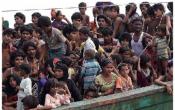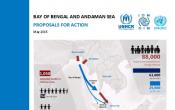Myanmar
Operation: Myanmar
Location
{"longitude":96,"latitude":22,"zoom_level":0}
Latest update of camps and office locations 21 Nov 2016. By clicking on the icons on the map, additional information is displayed.
Key Figures
| 2017 planning figures | |
| 185,000 | IDPs will benefit from camp coordination and camp management support |
| 25,000 | IDP and refugee returnees will be assisted with civil status registration or documentation in the south-east of Myanmar |
| 6,500 | internally displaced households will receive shelter support |
| 700 | protection monitoring visits will be conducted in Rakhine State, Kachin State and northern Shan State |
| 450 | government officials will be trained on citizenship and birth registration standards and good practices |
| 20 | advocacy interventions on international standards for the protection of stateless persons will be conducted |
| 2015 end-year results | |
| 4,100 | IDPs received shelter support |
| 200 | stateless boat survivors were reunited with their families |
| 149 | government officials received training on citizenship and birth registration standards and good practices |
| 260,000 | people of concern were reached through protection monitoring in Kachin, northern Shan and Rakhine states |
| 178,000 | IDPs benefited from CCCM support in Rakhine and Kachin state |
Latest Updates and Related Links
People of Concern
19%
Increase in
2015
2015
| 2015 | 1,414,357 |
| 2014 | 1,186,501 |
| 2013 | 1,212,392 |

[["Asylum-seekers",1],["IDPs",451089],["Returned IDPs",25265],["Returned refugees",2],["Stateless",938000]]
Loading ...
Budgets and Expenditure for Myanmar
< Back
2015
{"categories":[2012,2013,2014,2015,2016,2017],"budget":[34.75700454,68.48157023,68.10870324,72.77272012,56.04791521,49.326675812],"expenditure":[21.88189904,29.29272236,21.52521921,17.61568966,null,null]}
{"categories":[2012,2013,2014,2015,2016,2017],"p1":[0.04,13.203885,6.09529354,25.313692,28.97865689,22.282485454],"p2":[9.95258629,12.06478301,12.94029106,15.99808438,2.61084634,3.368718044],"p3":[null,null,null,null,null,null],"p4":[24.76441825,43.21290222,49.07311864,31.46094374,24.45841198,23.675472314]}
{"categories":[2012,2013,2014,2015,2016,2017],"p1":[null,null,null,5.55763533,null,null],"p2":[6.06364951,5.07377229,5.66947559,3.86446935,null,null],"p3":[null,null,null,null,null,null],"p4":[15.81824953,24.21895007,15.85574362,8.19358498,null,null]}
Loading ...
CHOOSE A YEAR
- 2014
- 2015
- 2016
- 2017
Working environment
Myanmar will continue to be characterized by a combination of statelessness and protracted internal displacement, while being the country of origin for the majority of refugees in the South-East Asia region.Myanmar has recently experienced significant changes in its political landscape with the conclusion of the nationwide ceasefire agreement (NCA) in October 2015 and the formation of a new government led by the National League for Democracy (NLD) in April 2016. With political dialogue and the peace process being the first priorities for the new Government, it is anticipated that these developments will offer new opportunities for UNHCR to engage the Government on durable solutions for internally displaced people (IDPs) and refugees from Myanmar in Thailand, as well as to advocate improved rights for the stateless population. Nonetheless, restrictions on the freedom of movement of the stateless population and IDPs in Rakhine, as well as sporadic armed clashes in the north-eastern part of the country, are likely to continue.
Key priorities
In 2017 UNHCR will focus on:• building the capacity of and providing technical support to the Government to address statelessness in Rakhine and elsewhere in the country;
• monitoring the protection environment to support evidence-based advocacy interventions to address the main protection risks faced by UNHCR’s persons of concerns throughout Myanmar;
• supporting the Government in identifying and implementing durable solutions in Rakhine State, Kachin State and northern Shan State and in facilitating reintegration of refugee returnees in south-east Myanmar;
• responding to humanitarian needs in IDP camps through the provision of shelter, non-food item and camp management and coordination services as well as through protection interventions; and
• leadership of the protection sector and the combined leadership of Shelter/NFI and Camp Coordination and Camp Management clusters.




